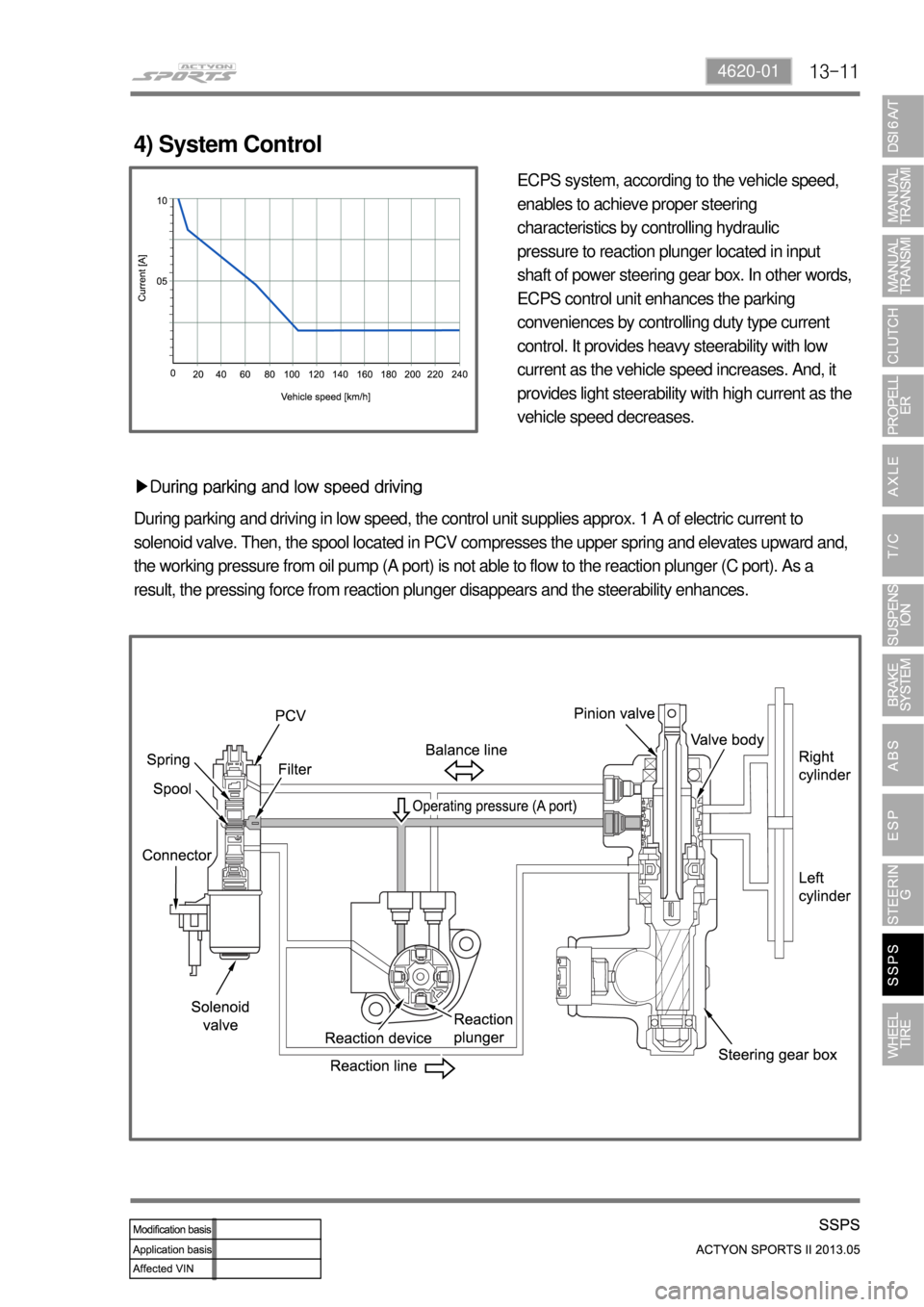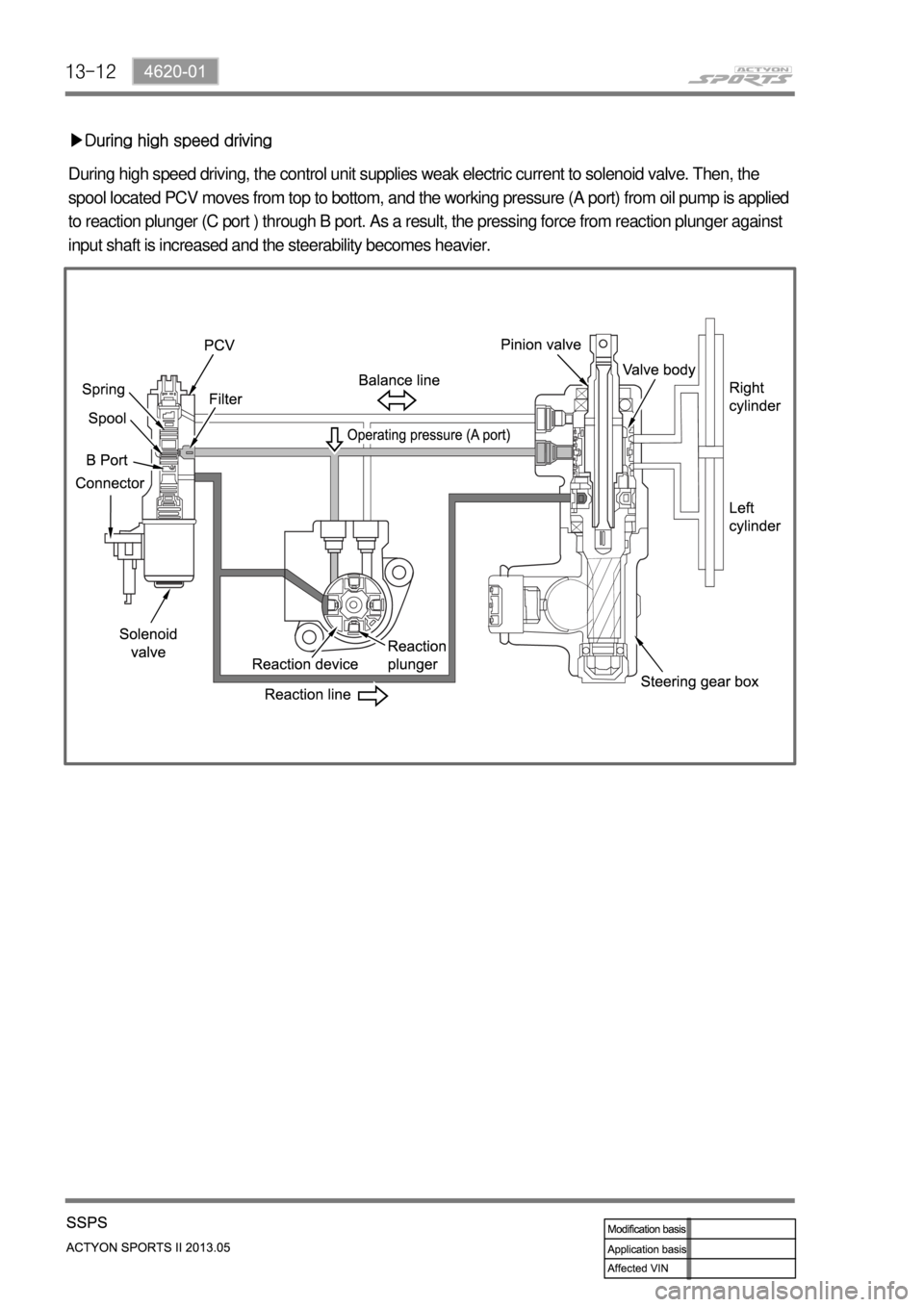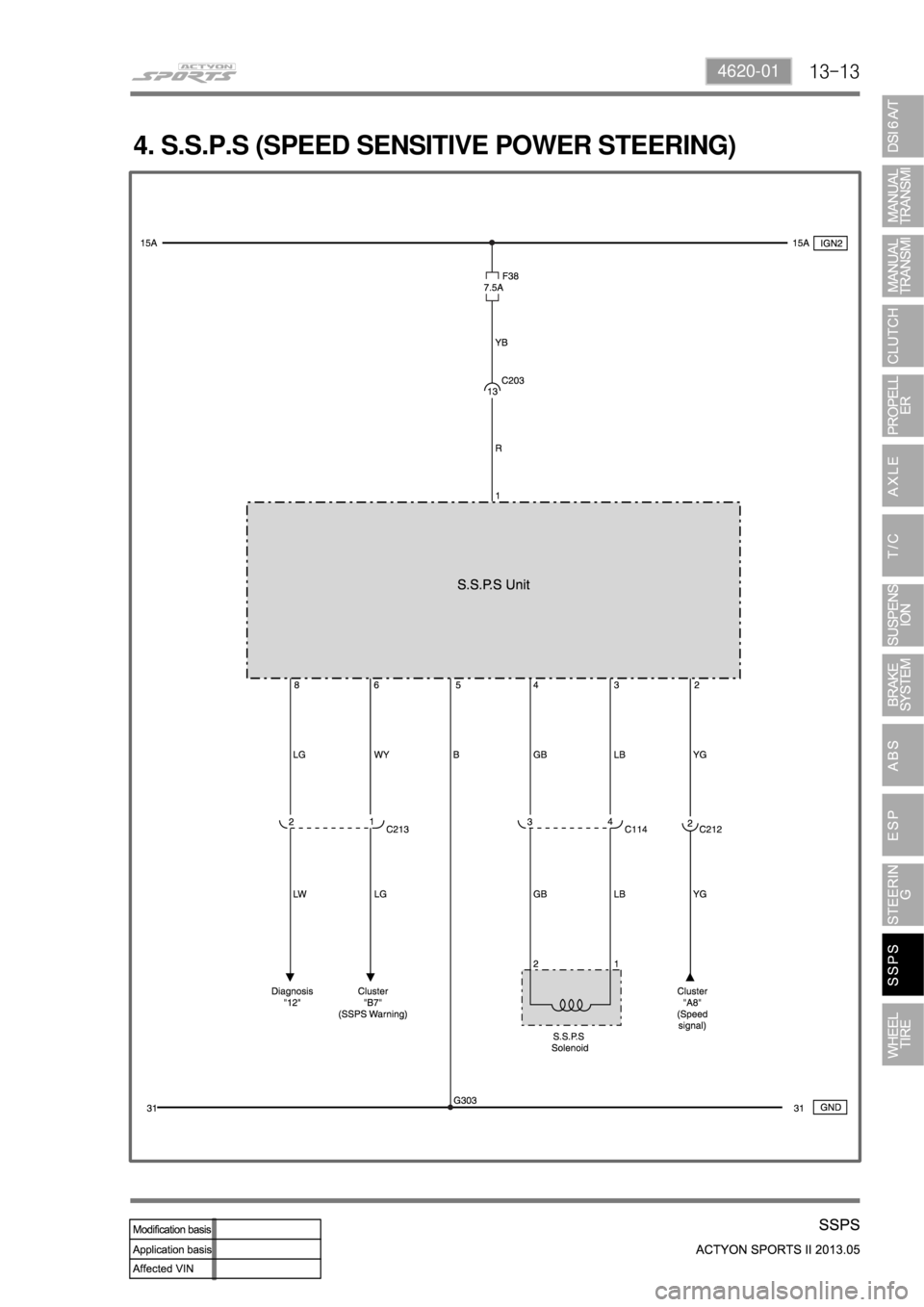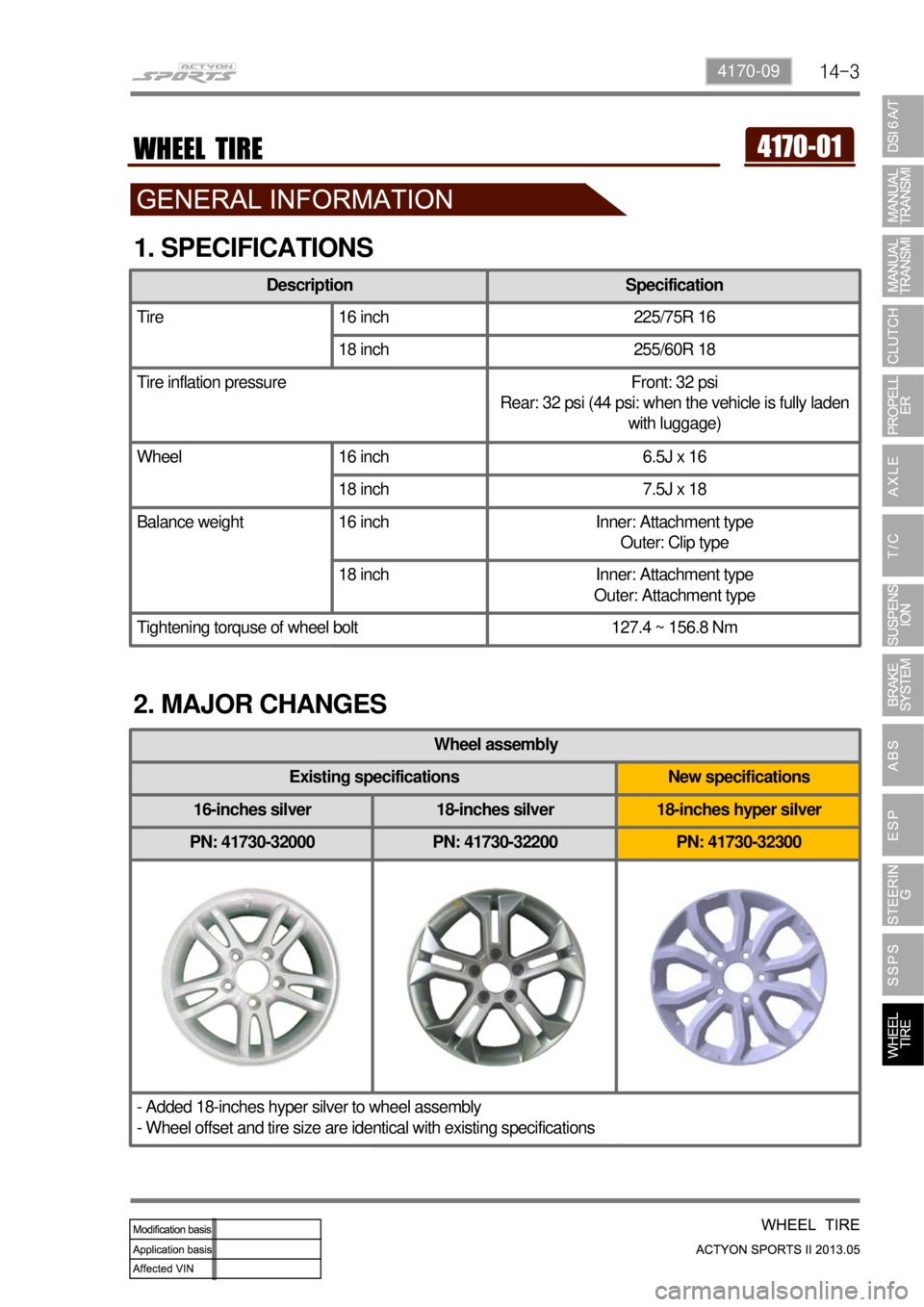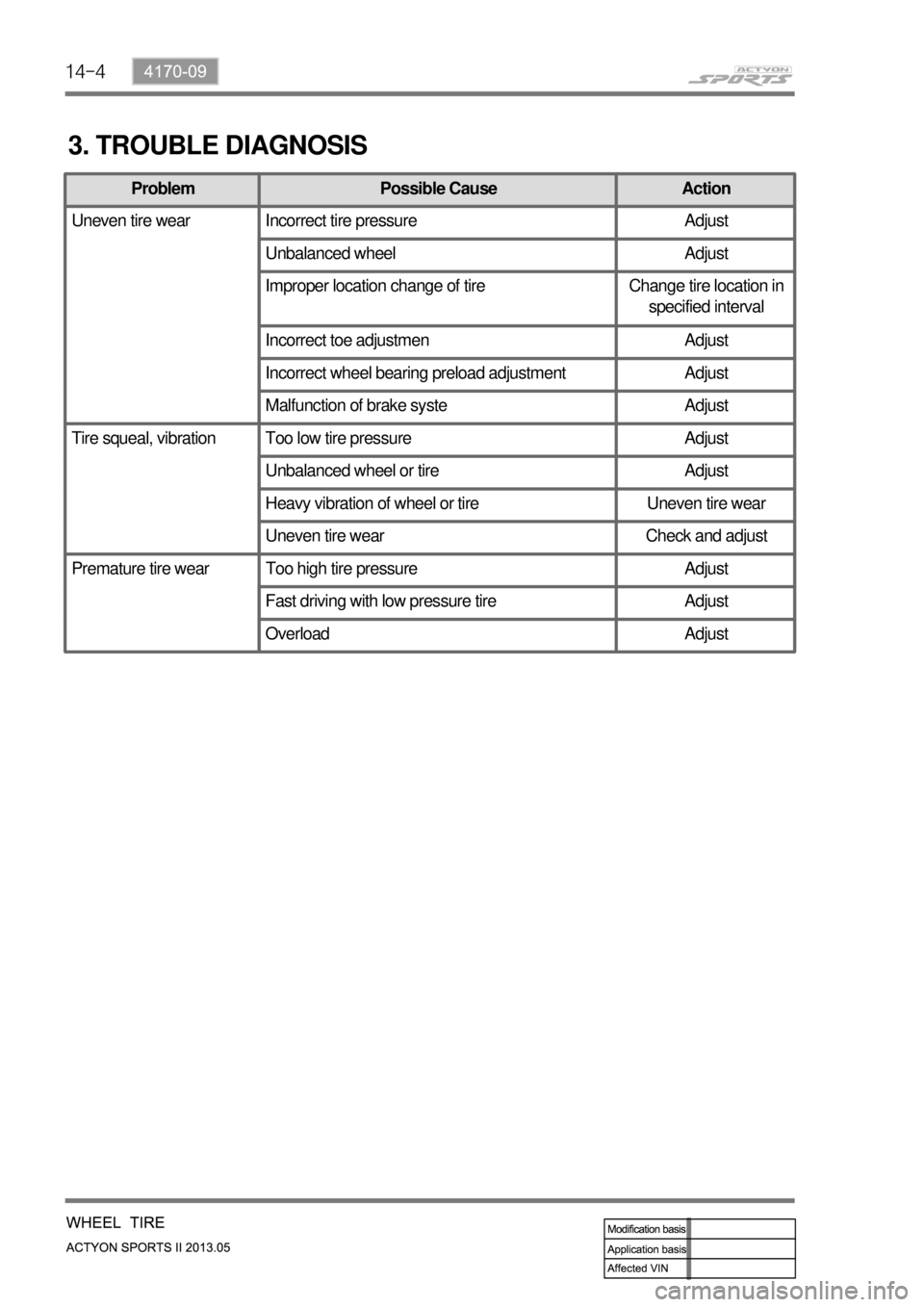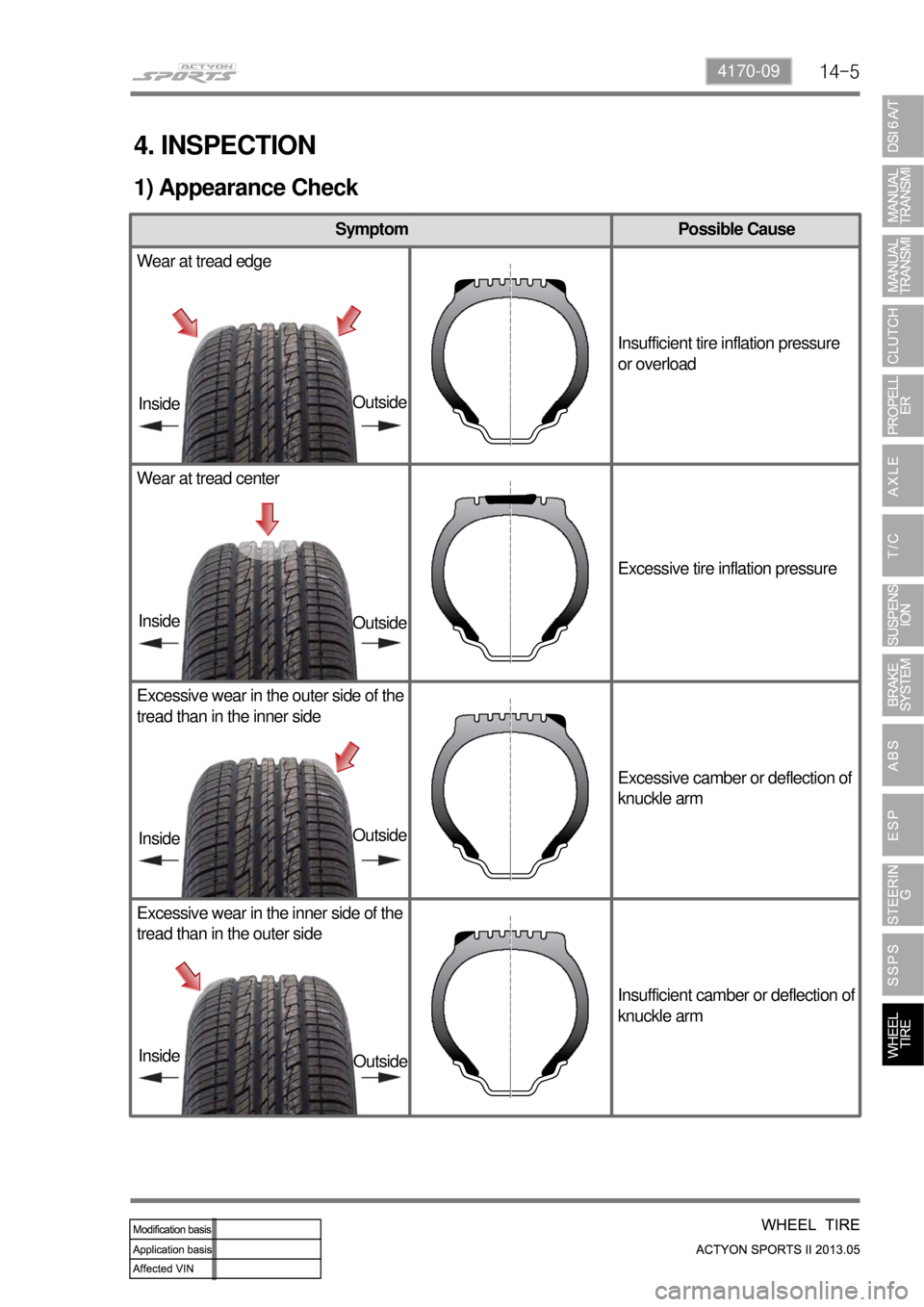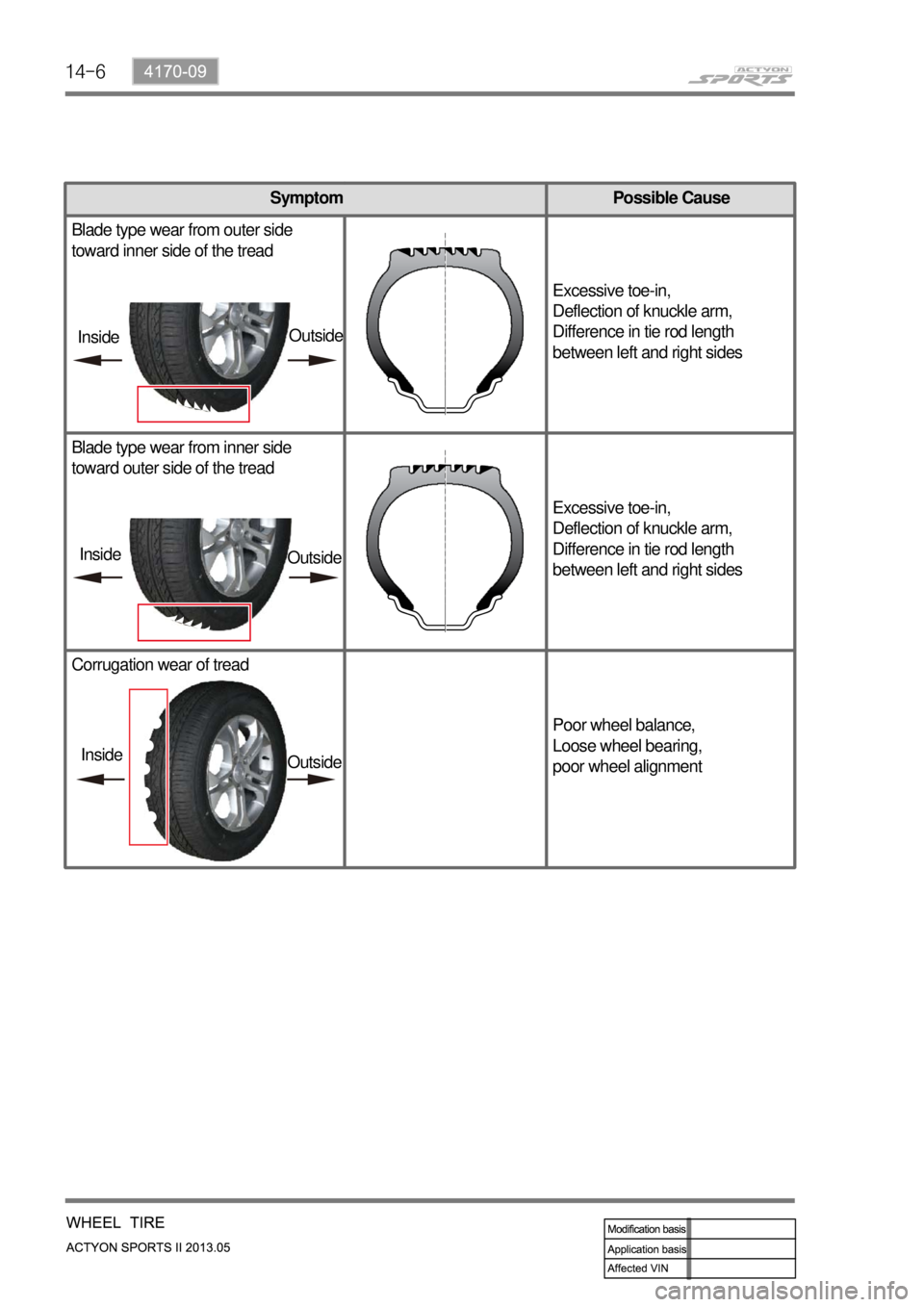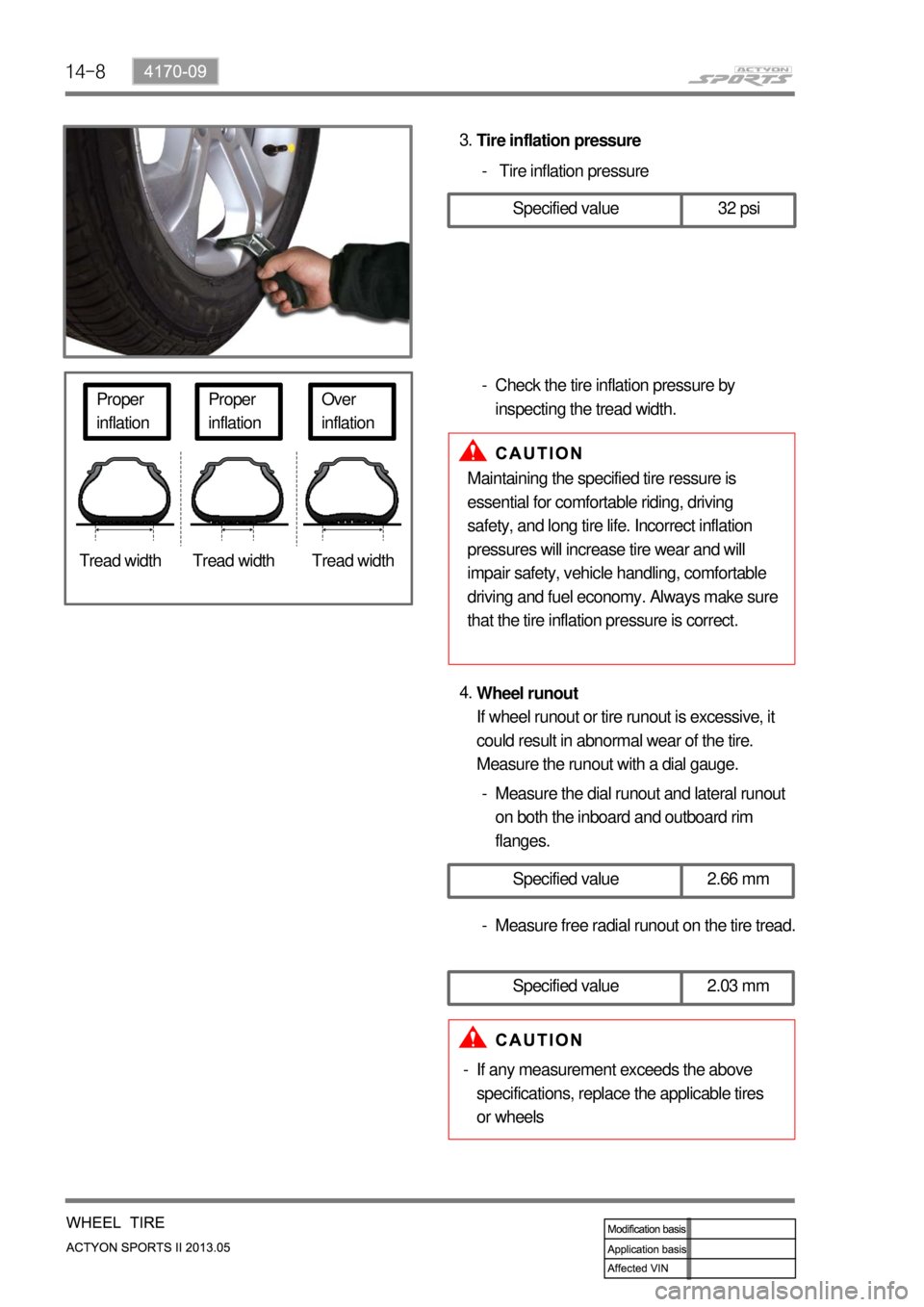SSANGYONG NEW ACTYON SPORTS 2013 Service Manual
NEW ACTYON SPORTS 2013
SSANGYONG
SSANGYONG
https://www.carmanualsonline.info/img/67/57512/w960_57512-0.png
SSANGYONG NEW ACTYON SPORTS 2013 Service Manual
Trending: child seat, alarm, battery capacity, checking oil, radio, instrument cluster, tire pressure
Page 661 of 751
13-114620-01
4) System Control
ECPS system, according to the vehicle speed,
enables to achieve proper steering
characteristics by controlling hydraulic
pressure to reaction plunger located in input
shaft of power steering gear box. In other words,
ECPS control unit enhances the parking
conveniences by controlling duty type current
control. It provides heavy steerability with low
current as the vehicle speed increases. And, it
provides light steerability with high current as the
vehicle speed decreases.
▶During parking and low speed driving
During parking and driving in low speed, the control unit supplies approx. 1 A of electric current to
solenoid valve. Then, the spool located in PCV compresses the upper spring and elevates upward and,
the working pressure from oil pump (A port) is not able to flow to the reaction plunger (C port). As a
result, the pressing force from reaction plunger disappears and the steerability enhances.
Page 662 of 751
13-12
▶During high speed driving
During high speed driving, the control unit supplies weak electric current to solenoid valve. Then, the
spool located PCV moves from top to bottom, and the working pressure (A port) from oil pump is applied
to reaction plunger (C port ) through B port. As a result, the pressing force from reaction plunger against
input shaft is increased and the steerability becomes heavier.
Page 663 of 751
13-134620-01
4. S.S.P.S (SPEED SENSITIVE POWER STEERING)
Page 664 of 751
14-34170-09
1. SPECIFICATIONS
2. MAJOR CHANGES
Wheel assembly
16-inches silver 18-inches silver 18-inches hyper silver
PN: 41730-32000 PN: 41730-32200 PN: 41730-32300
- Added 18-inches hyper silver to wheel assembly
- Wheel offset and tire size are identical with existing specifications
Existing specifications New specifications
Description Specification
Tire 16 inch 225/75R 16
18 inch 255/60R 18
Tire inflation pressure Front: 32 psi
Rear: 32 psi (44 psi: when the vehicle is fully laden
with luggage)
Wheel 16 inch 6.5J x 16
18 inch 7.5J x 18
Balance weight 16 inch Inner: Attachment type
Outer: Clip type
18 inch Inner: Attachment type
Outer: Attachment type
Tightening torquse of wheel bolt 127.4 ~ 156.8 Nm
Page 665 of 751
14-4
3. TROUBLE DIAGNOSIS
Problem Possible Cause Action
Uneven tire wear Incorrect tire pressure Adjust
Unbalanced wheel Adjust
Improper location change of tire Change tire location in
specified interval
Incorrect toe adjustmen Adjust
Incorrect wheel bearing preload adjustment Adjust
Malfunction of brake syste Adjust
Tire squeal, vibration Too low tire pressure Adjust
Unbalanced wheel or tire Adjust
Heavy vibration of wheel or tire Uneven tire wear
Uneven tire wear Check and adjust
Premature tire wear Too high tire pressure Adjust
Fast driving with low pressure tire Adjust
Overload Adjust
Page 666 of 751
14-54170-09
Symptom Possible Cause
Wear at tread edge
Insufficient tire inflation pressure
or overload
Wear at tread center
Excessive tire inflation pressure
Excessive wear in the outer side of the
tread than in the inner side
Excessive camber or deflection of
knuckle arm
Excessive wear in the inner side of the
tread than in the outer side
Insufficient camber or deflection o
f
knuckle arm
1) Appearance Check
4. INSPECTION
InsideOutside
Inside
Outside
InsideOutside
Inside
Outside
Page 667 of 751
14-6
Symptom Possible Cause
Blade type wear from outer side
toward inner side of the tread
Excessive toe-in,
Deflection of knuckle arm,
Difference in tie rod length
between left and right sides
Blade type wear from inner side
toward outer side of the tread
Excessive toe-in,
Deflection of knuckle arm,
Difference in tie rod length
between left and right sides
Corrugation wear of tread
Poor wheel balance,
Loose wheel bearing,
poor wheel alignment
InsideOutside
Inside
Outside
Inside
Outside
Page 668 of 751
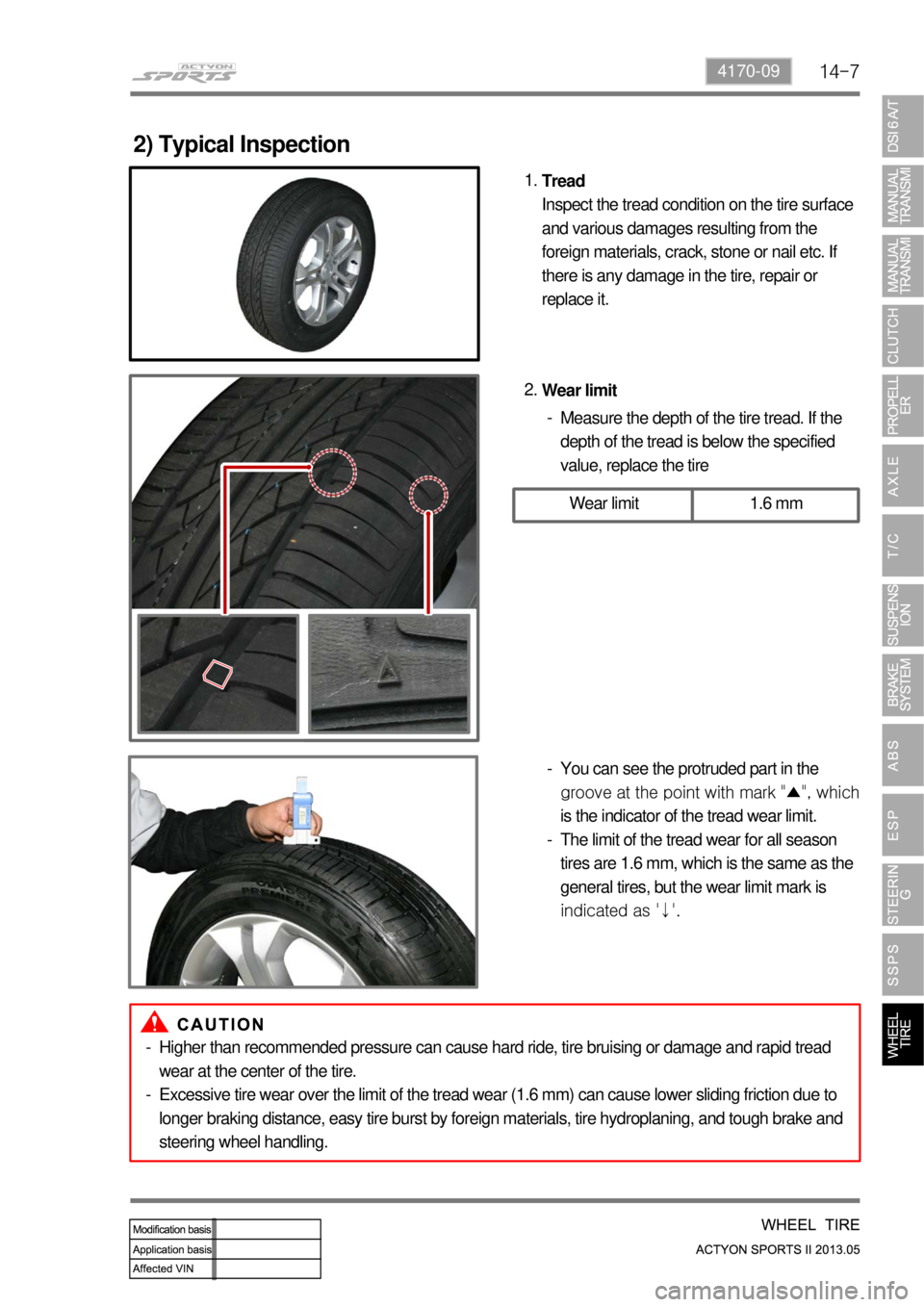
14-74170-09
2) Typical Inspection
Tread
Inspect the tread condition on the tire surface
and various damages resulting from the
foreign materials, crack, stone or nail etc. If
there is any damage in the tire, repair or
replace it. 1.
Wear limit 2.
Measure the depth of the tire tread. If the
depth of the tread is below the specified
value, replace the tire -
You can see the protruded part in the
groove at the point with mark "▲", which
is the indicator of the tread wear limit.
The limit of the tread wear for all season
tires are 1.6 mm, which is the same as the
general tires, but the wear limit mark is
indicated as '↓'. -
-
Wear limit 1.6 mm
Higher than recommended pressure can cause hard ride, tire bruising or damage and rapid tread
wear at the center of the tire.
Excessive tire wear over the limit of the tread wear (1.6 mm) can cause lower sliding friction due to
longer braking distance, easy tire burst by foreign materials, tire hydroplaning, and tough brake and
steering wheel handling. -
-
Page 669 of 751
14-8
Measure the dial runout and lateral runout
on both the inboard and outboard rim
flanges. - Tire inflation pressure -
Check the tire inflation pressure by
inspecting the tread width. -
Specified value 2.66 mm
Wheel runout
If wheel runout or tire runout is excessive, it
could result in abnormal wear of the tire.
Measure the runout with a dial gauge. 4.
Measure free radial runout on the tire tread. -
Specified value 2.03 mm
If any measurement exceeds the above
specifications, replace the applicable tires
or wheels -Tire inflation pressure 3.
Specified value 32 psi
Maintaining the specified tire ressure is
essential for comfortable riding, driving
safety, and long tire life. Incorrect inflation
pressures will increase tire wear and will
impair safety, vehicle handling, comfortable
driving and fuel economy. Always make sure
that the tire inflation pressure is correct.
Proper
inflationProper
inflationOver
inflation
Tread width Tread width Tread width
Page 670 of 751
14-94170-09
Wheel balance 5.
Check the wheel balance when the wheel
is unbalanced or the tire is repaired.
The total weight of the wheel weight
should not exceed 150 g.
Ensure that the balance weight installed is
not projected over 3mm from the wheel
surface.
Use the specified aluminum wheel balance
weights for aluminum wheels.
Weight balance can be added by 5 g.
There are two types of weight balance,
tape type and adhesion type. -
-
-
-
-
-
Make sure to read the manual of the
manufacturer thoroughly before using
wheel balance tester. -
Change tire location
To avoid uneven wear of tires and to prolong
tire life, inspect and rotate your tires every
5,000 km. 6.
Mixing tires could cause to lose control while driving. Be sure to use the same size and type tires of
the same manufacturer on all wheels. -
Trending: power steering fluid, display, lane assist, gearbox, open gas tank, automatic transmission, instrument panel
